| Listing 1 - 10 of 39 | << page >> |
Sort by
|
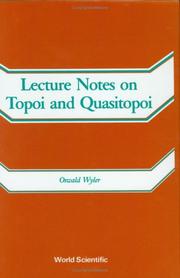
ISBN: 9810201532 9789810201531 Year: 1991 Publisher: Singapore: World scientific,
Abstract | Keywords | Export | Availability | Bookmark
 Loading...
Loading...Choose an application
- Reference Manager
- EndNote
- RefWorks (Direct export to RefWorks)
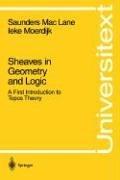
ISBN: 0387977104 3540977104 1461209277 0387977102 9780387977102 9781461209270 Year: 1992 Publisher: New York, N.Y. Springer-Verlag
Abstract | Keywords | Export | Availability | Bookmark
 Loading...
Loading...Choose an application
- Reference Manager
- EndNote
- RefWorks (Direct export to RefWorks)
This text presents topos theory as it has developed from the study of sheaves. Sheaves arose in geometry as coefficients for cohomology and as descriptions of the functions appropriate to various kinds of manifolds (algebraic, analytic, etc.). Sheaves also appear in logic as carriers for models of set theory as well as for the semantics of other types of logic. Grothendieck introduced a topos as a category of sheaves for algebraic geometry. Subsequently, Lawvere and Tierney obtained elementary axioms for such (more general) categories.This introduction to topos theory begins with a number of illustrative examples that explain the origin of these ideas and then describes the sheafification process and the properties of an elementary topos. The applications to axiomatic set theory and the use in forcing (the Independence of the Continuum Hypothesis and of the Axiom of Choice) are then described. Geometric morphisms- like continuous maps of spaces and the construction of classifying topoi, for example those related to local rings and simplicial sets, next appear, followed by the use of locales (pointless spaces) and the construction of topoi related to geometric languages and logic. This is the first text to address all of these varied aspects of topos theory at the graduate student level.
Toposes. --- Toposes --- Algebraic topology
Book
ISBN: 019875891X 9780198758914 Year: 2018 Publisher: Oxford: Oxford university press,
Abstract | Keywords | Export | Availability | Bookmark
 Loading...
Loading...Choose an application
- Reference Manager
- EndNote
- RefWorks (Direct export to RefWorks)
The aim of this book is to present a theory and a number of techniques which allow to give substance to Grothendieck's vision of the notion of topos. This has been accomplished by building on the notion of classifying topos educed by categorical logicians. Mathematical theories (formalized within first-order logic) give rise to geometric objects called sites; the passage from sites to their associated toposes embodies the passage from the logical presentation of theories to their mathematical content, i.e. from syntax to semantics. The essential ambiguity given by the fact that any topos is associated in general with an infinite number of theories or different sites allows to study the relations between different theories, and hence the theories themselves, by using toposes as 'bridges' between these different presentations. The expression or calculation of invariants of toposes in terms of the theories associated with them or their sites of definition generates a great number of results and notions varying according to the different types of presentation, giving rise to a veritable mathematical morphogenesis.
Book
Year: 1971 Publisher: Århus : Århus universitet,
Abstract | Keywords | Export | Availability | Bookmark
 Loading...
Loading...Choose an application
- Reference Manager
- EndNote
- RefWorks (Direct export to RefWorks)
Book
ISBN: 0444867112 9781483299211 148329921X 1322479860 9780444867117 Year: 1984 Volume: 98 Publisher: Amsterdam, Netherlands ; New York, New York : North-Holland,
Abstract | Keywords | Export | Availability | Bookmark
 Loading...
Loading...Choose an application
- Reference Manager
- EndNote
- RefWorks (Direct export to RefWorks)
The first of its kind, this book presents a widely accessible exposition of topos theory, aimed at the philosopher-logician as well as the mathematician. It is suitable for individual study or use in class at the graduate level (it includes 500 exercises). It begins with a fully motivated introduction to category theory itself, moving always from the particular example to the abstract concept. It then introduces the notion of elementary topos, with a wide range of examples and goes on to develop its theory in depth, and to elicit in detail its relationship to Kripke's intuitionistic semantics,
Mathematical logic --- Toposes. --- Topoi (Mathematics) --- Categories (Mathematics) --- Toposes
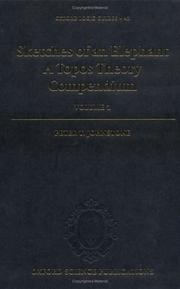
ISBN: 019852496X 0198534256 0198515987 9780198534259 9780198515982 9780198524960 Year: 2008 Volume: 43-44 Publisher: Oxford: Oxford university press,
Abstract | Keywords | Export | Availability | Bookmark
 Loading...
Loading...Choose an application
- Reference Manager
- EndNote
- RefWorks (Direct export to RefWorks)
Mathematical logic --- Category theory. Homological algebra --- Toposes --- Toposes.
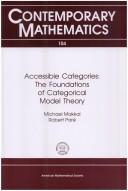
ISBN: 082185111X Year: 1989 Publisher: Providence (R.I.) : American mathematical society,
Abstract | Keywords | Export | Availability | Bookmark
 Loading...
Loading...Choose an application
- Reference Manager
- EndNote
- RefWorks (Direct export to RefWorks)
Book
ISBN: 0840503520 Year: 1977 Publisher: Montréal
Abstract | Keywords | Export | Availability | Bookmark
 Loading...
Loading...Choose an application
- Reference Manager
- EndNote
- RefWorks (Direct export to RefWorks)
Mathematical logic --- Ordered algebraic structures --- Toposes.
Book
ISBN: 9780486462868 0486462862 Year: 2008 Publisher: Mineola, N.Y.: Dover,
Abstract | Keywords | Export | Availability | Bookmark
 Loading...
Loading...Choose an application
- Reference Manager
- EndNote
- RefWorks (Direct export to RefWorks)
Topos theory has led to unexpected connections between classical and constructive mathematics. This text explores Lawvere and Tierney's concept of topos theory, a development in category theory that unites important but seemingly diverse notions from algebraic geometry, set theory, and intuitionistic logic. A virtually self-contained introduction, this volume presents toposes as the models of theories — known as local set theories — formulated within a typed intuitionistic logic. The introductory chapter explores elements of category theory, including limits and colimits, functors, adjunctions, Cartesian closed categories, and Galois connections. Succeeding chapters examine the concept of topos, local set theories, fundamental properties of toposes, sheaves, locale-valued sets, and natural and real numbers in local set theories. An epilogue surveys the wider significance of topos theory, and the text concludes with helpful supplements, including an appendix, historical and bibliographical notes, references, and indexes.
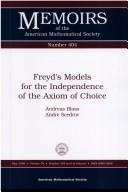
ISBN: 0821824686 Year: 1989 Publisher: Providence (R.I.): American Mathematical Society
Abstract | Keywords | Export | Availability | Bookmark
 Loading...
Loading...Choose an application
- Reference Manager
- EndNote
- RefWorks (Direct export to RefWorks)
| Listing 1 - 10 of 39 | << page >> |
Sort by
|

 Search
Search Feedback
Feedback About UniCat
About UniCat  Help
Help News
News